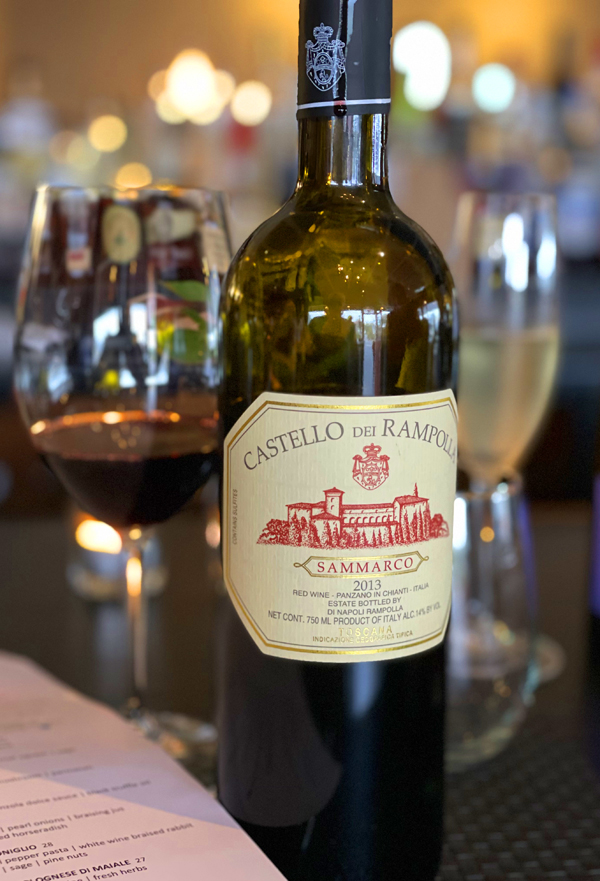2013 Castello dei Rampolla, Sammarco, IGT Rosso, Tuscany, Italy.
One of the first Super Tuscan wines I really got to know early in my career in the wine business, Castello dei Rampolla’s Sammarco, mostly Cabernet Sauvignon and grown in the Chianti Classico zone of Tuscany, at almost the half way point between Florence and Siena in Panzano, which makes it special to me and I was thrilled to re-visit this deep and Bordeaux like 2013 vintage. I think the first impression of I had of Sammarco I had professionally was the rustic charm it displayed, it was the1996, which was not a remarkable year, but I loved that way and I was drawn in forever to these Castello dei Rampolla wines, and this 2013 re-ignited that flame with its uniquely italian feel, it was made from about 90% Cabernet Sauvignon, 5% Sangiovese, and 5% Merlot, making for a very dark and structured wine. The vinous, mature and evolved medium/full bodied palate of this Sammarco is neither heavy or flamboyant, but more elegant, earthy and poised, not trying to show off, it delivers blackberry, mulberry/currant, plum and dusty cherry fruits that are accented nicely with green spice, tobacco leaf, loamy dry earth, mineral tones, minty anise, a hint of smoky oak and dried dark flowers. I would never say this wine is shy or a wallflower, but this wine didn’t shine in its best light until matched with food, then it opened its arms wide and embraced the moment to the fullest and impressed with its brilliance. The Castello dei Rampolla is owned and run by the Di Napoli family, currently with Maurizia and Luca in charge and with Maurizia making the wines here, which have a cult following, especially for this Sammarco, and the ultra rare d’Alco, made from 85% Cabernet Sauvignon and 15% Petit Verdot. These are single vineyard wines set on the classic Galestro soils and on mainly South facing slopes that soak up the beautiful Tuscan sun and give these grapes wonderful fruit density, color and aromatics. This artisan nature of the wines, with hand tended vines and small yields here is compelling and the passion for sustainable production is very admirable, which adds to the pleasure in drinking these wines, they’ve never been cheap, but they are worth it.
Castello dei Rampolla, one of Tuscany’s most historic estates, owned by the Di Napoli family since 1964, is in Chianti Classico’s Panzano region and located in Conca d’Oro, a picturesque area with centuries of winemaking tradition. Interestingly, Castello dei Rampolla has only bottled their estate wines as such since 1975, but was one of a small number of famous wineries that led to the revival of the Chianti Classico wines, which had lost its way and had tarnished its prized reputation for quality, native authentic taste and regional distinction. It is then somewhat ironic that Castello dei Rampolla, who have been all biodynamic since 1994, are almost better known for their International varietal bottlings than their pure indigenous Sangiovese bottlings, like this Cabernet Sauvignon based Sammarco. Like most of the best towns in Chianti Classico, Panzano’s altitude and hill top exposure makes it the quality location it is, notably it is never really excessively hot even during August, allowing for perfect ripening conditions to make balanced wines. The dark feuding history between Florence and Siena led to the destruction of Panzano on many occasions durning the 1200s, 1300s and as late as the1500s, but thankfully now it is a wonderfully peaceful place, home to beautiful farms and estates that produce fine wine, olive oil and some of the best meats in Italy. The pedigreed Sammarco, the first biodynamic Super Tuscan, was originally made and predated Ornellaia in1980 and had the famous Giacomo Tachis, who consulted with Sassicaia, Solaia and the mentioned Ornellaia! The fermentation happens in concrete vats, 100% de-stewmmed, and macerated for 30 days before being racked to barrel, which are a combination of French barriques, large casks and 500L tonneaux, where the Sammarco ages between 14 to 16 months. After which the wine is rested in bottle for another 24 months before release, allowing all the flavors to meld together and tame the youthful tannins, as this vintage shows, having almost ten years to develop. In recent years, with the move towards native grapes only in Chianti Classico and Riserva(s), Castello dei Rampolla has risen to the occasion and I highly recommend them, as well as these exotic Cab led offerings of course.
($99 Est.) 94 Points, grapelive
